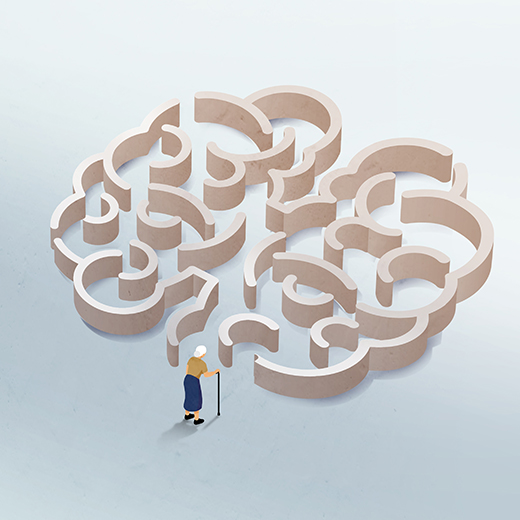 Alzheimer’s is a neurodegenerative disease that usually develops very gradually and is very complex. From seemingly insignificant problems with concentration, through small memory loss to the development of dementia disorders noticeable by everyone else. The causes of Alzheimer’s have not been fully understood; hence it is impossible to present one effective one way to prevent it. However, the development of medical sciences, the involvement of scientific teams around the world and the results of their latest research shed some light on the mechanism the development of Alzheimer’s disease and hence in ways to prevent it.
Alzheimer’s is a neurodegenerative disease that usually develops very gradually and is very complex. From seemingly insignificant problems with concentration, through small memory loss to the development of dementia disorders noticeable by everyone else. The causes of Alzheimer’s have not been fully understood; hence it is impossible to present one effective one way to prevent it. However, the development of medical sciences, the involvement of scientific teams around the world and the results of their latest research shed some light on the mechanism the development of Alzheimer’s disease and hence in ways to prevent it.
Alzheimer’s disease most often occurs in people over the age of 65, but in some cases the first symptoms may appear earlier. Its course varies from patient to patient; nevertheless, many similar symptoms can be distinguished. In the early stages, the most common symptom is having difficulties in remembering recent events. As the disease progresses, symptoms such as confusion, long-term memory loss, confusion in time and space, language difficulties, mood swings or aggression, and the inability to perform many normal daily activities appear. Because of these ailments, patients exclude themselves from family and social life, and their life functions are gradually lost, which eventually leads to death. In any patient, the disease can however, be different and develop at a different pace.
There are several hypotheses about the causes of Alzheimer’s disease. The so-called “Tau hypothesis” is that a morbid chain of events begins with an abnormality in the structure of the tau protein, which is present almost exclusively in nerve cells. The hyperphosphorylated strands of the tau protein begin to bind, creating neurofibrillary tangles, i.e., pathological structures inside the bodies of neurons; this in turn leads to the disintegration of the microtubule (the fibrous, tubular structure that gives the cell its shape), destroying the neural transport system. The result is a functional biochemical communication impairment between neurons followed by the death of the cell. An oxidative stress and disturbed metal metabolic homeostasis may also play a vital role in the development of Alzheimer’s disease.
In addition, patients with this disease lose 70% of the cells in the cavity (the nuclei of the brainstem) that produce the neurotransmitter norepinephrine. Scientists suggest that this process can cause an increased, abnormal, harmful deposit in the structure of the protein, amyloid β, in the patient’s brain. It was also found that the presence of pathologically structured proteins activates glial cells, which, next to nerve cells, are the second largest component of the nervous tissue system in the brain. This activates the processes accompanying inflammation – the release of free radicals, nitric oxide, and inflammatory interleukins, which also contribute to the death of neurons and their connections.
Alzheimer’s disease is characterized by the loss of neurons and synapses in the cortex of the brain and certain subcortical regions. This leads to degeneration in the temporal and parietal lobes as well as in some parts of frontal lobe. Age plaques and neurofibrillary tangles appear in the brain. The plaques form betaamyloid peptides deposits and cellular material outside of cells, around neurons. A genetic test can be performed to assess the risk of developing Alzheimer’s disease. It allows you to define the form of the ApoE gene responsible for the predisposition to this disease. The early-onset of the disease is caused by mutations in the presenilin 1 (PSEN1) and presenilin 2 genes (PSEN2) or in the β-amyloid precursor (APP) gene.
THE ROLE OF EPIGENETICS IN PREVENTING ALZHEIMER’S DISEASE
Epigenetics is the study of changes in gene expression which is modified by external factors and may be inherited. The epigenome is a set of DNA modifications and histone proteins (linked to the DNA of proteins found in the nucleus cells) that control gene expression, DNA replication and repair, and other cellular functions. It can determine which genes will be active and program cell functions. This means that we can influence gene expression, turn them on and off, which is especially important in the case of genetic mutations responsible for various diseases.
How can we do this? By modifying your lifestyle, such as changing your diet, avoiding exposure to toxins, playing sports, or having a healthy sleep routine. The system developed by Dr. Barry Reisberg of New York University divides the progression of Alzheimer’s disease into seven stages. The criterion for this division depends on the degree of cognitive impairment. The distinguished neurologist Dr. David Perlmutter claims that the disease is reversible up to stage 5, which is the moment when patients are no longer capable of self-reliance functioning. Even in the 6th stage, when the loss of cognitive functions is very large, you can prevent further disease progression.
HOW TO INCREASE THE NUMBER OF NEURONS – NEUROGENESIS and BDNF
It is now common knowledge that we produce new nerve cells throughout our lives, between others in the hippocampus, a small structure located in the temporal lobe of the cerebral cortex forebrain responsible mainly for memory. As it turns out, the growth of new cells in the nervous system, called neurogenesis, is carried out under the control of a neurotrophic factor of origin the brain, i.e., the BDNF protein. BDNF performs several functions in the brain: it acts on selected central neurons and peripheral nervous system supporting the survival of the existing neurons, promotes the formation and differentiation of new neurons and synapses, and induces new brain cells growth.
In January 2014, scientists in “JAMA Neurology” published a report in which they presented the results of a study conducted on a group of over 2,000 adults free of dementia. First, they measured the level of BDNF, and then the subjects were observed for about 10 years. The researchers found that those with the highest BDNF levels at the start of the study had a much lower risk of developing dementia and Alzheimer’s disease compared to those in which a low level had been observed. The study also found that there are two strong lifestyle factors that influence higher BDNF levels. These include aerobic exercise and reducing carbohydrate consumption.
Studies have shown that people with normal conditions have a much lower risk of developing Alzheimer’s the level of BDNF, which is a factor that controls the growth of new nerve cells.
Studies have shown that people with normal conditions have a much lower risk of developing Alzheimer’s the level of BDNF, which is a factor that controls the growth of new nerve cells.
In another interesting study, published in the Journal of Alzheimer’s Disease, scientists at four research institutes followed 876 adults over the age of 30 and recorded data on the amount and type of exercise they performed. Moreover, each of the subjects underwent detailed psychiatric tests and magnetic resonance imaging to determine the functioning condition of their brain. The results were amazing. Scientists have shown that those people that had exercised more, had a significant increase in the amount of gray matter in the brain, compared to those that were less active, which resulted in a reduction of the risk of Alzheimer’s disease by as much as 50%. So, exercise is the most effective way to increase your BDNF levels. They improve blood flow to the brain that transports oxygen and essential nutrients. Thanks to this, the brain is able to get rid of toxic by-products accumulated during the day and increase your resistance to inflammation. Exercise is also a powerful insulin sensitizer, i.e., a factor increasing the body’s ability to react to its action. Exercise improves in addition, the quality and duration of sleep, the period during which the brain regenerates. Not only because it increases the abundance of oxygen in the brain, but also the number of trophic factors that stimulate cellular renewal.

NEUROPLASTIC
The term neuroplasticity denotes the ability of nerve tissue to form new connections aimed at their reorganization, adaptation, changeability, and self-repair. It is crucial for learning and memory processes. According to Dr. Michael Merzenich, professor emeritus and neurobiologist, creator of the concept of neuroplasticity: – At any point in life, we can improve operational status of our brain and it depends on us. – This means that at any time, even in old age, we can “reprogram” our brain, because it is constantly plastic. Neuroplasticity is the ability of the brain to change and is made possible by neurogenesis. In Alzheimer’s disease and depression, this is reduced. However, we can influence the brain through challenging yourself, exercising the mind and body, and having a healthy diet. We can reprogram it in such a way that it is resistant to neurodegeneration. We have the option to accelerate its work and remodel it by creating new connections between neurons and even stimulating the formation of new nerve cells.
Thanks to the plasticity of the brain, we can improve its operational status even in old age through mental challenges, exercise, and a healthy diet. We can reprogram it in such a way that it will be resistant to neurodegeneration.
Epigenetics and neuroplasticity are closely related. Introducing epigenetic changes lifestyle issues such as the ketogenic diet, exercise, and fasting lead to an increase in the levels of ketones. Ketones are regulators that can alter the methylation and demethylation of genes. The health of patients with Alzheimer’s disease is also improved by music therapy, as it stimulates new neurons to grow. Other ways to stimulate the brain include various kinds of logic games, puzzles as well learning foreign languages.
ALZHEIMER DIABETES TYPE 3?
Dr. Ben Johnson, a physician, biologist, and psychologist, in an interview with Jonathan Otto, says that in the case of Alzheimer’s disease, many factors are involved in the disease process, ranging from heavy metals through toxins to inflammation. Brain atrophy is part of this inflammatory process, which is caused by, among other things, high glucose levels.
Recently, researchers proposed the term “type 3 diabetes” for Alzheimer’s disease, which is the term discussed in more detail, inter alia, in “Biochim Biophys Acta” in 2017. The name is not accidental, because the disease shares molecular and cellular characteristics with type 1 diabetes, type 2 diabetes, and insulin resistance, associated with memory deficits and cognitive decline in older individuals.
In addition, it has been found that insulin is involved in the activation of glycogen synthase kinase 3β, which in turn causes phosphorylation of the tau protein, which is involved in the formation of neurofibrillary tangles. Interestingly, insulin also plays a key role in the formation of amyloid plaques. Hence in the prevention and treatment of Alzheimer’s, a proper diet is of utmost importance, in which it is of key importance avoiding sugar and high-carbohydrate foods. It’s the spikes in blood glucose that cause Alzheimer’s disease, diabetes, and cancer. They cause damage throughout the body, from the brain through to the pancreas, down to the capillaries and nerves. They also contribute to the development of cancerous cells. They are one of the most harmful factors to our health.
Swedish scientists checked how red blood cells change in type 2 diabetes and how it affects risk of cardiovascular complications. Professor John Pernow, based on research carried out on mice stated: – We found that healthy blood vessels were exposed to red blood cells from patients with type 2 diabetes were damaged. – A team of scientists said that these deleterious effects were related to the increased activity of the arginase enzyme, which increased the amount of harmful free radicals in the blood vessels.
Type 2 diabetes occurs when the body is flooded with sugar for so long that the cells cannot take it anymore, “closing” the sites of insulin receptors. This phenomenon is called insulin resistance. Dr. Nuzum states that we may also be dealing with an insulin resistant brain, leading to the deposition of β amyloid proteins that interfere with our ability to recall various events or information and disrupting memory, and this causes the development of Alzheimer’s disease. Hence, some doctors and scientists refer to it as type 3 diabetes.
Based on recent research, the term “type 3 diabetes” has been proposed for Alzheimer’s disease. The name is not accidental, as the disease shares common features with type 1 and type 2 diabetes and insulin resistance, associated with memory deficits and cognitive deterioration in older people.
As argued by Dr. hab. med. Monika Karczewska-Kupczewska from the Department of Internal Medicine and Metabolic Medical Diseases at the University of Bialystok, more and more studies indicate that insulin resistance plays a significant role in the pathogenesis of Alzheimer’s and Parkinson’s diseases. Over 80% of the patients with Alzheimer’s disease were diagnosed with type 2 diabetes or impaired glucose tolerance. Research like these published in 2017 in Frontiers in Aging Neuroscience prove that one of the main causes of this condition is hyperinsulinemia, also known as pre-diabetes.
In the state of the so-called pre-diabetic insulin levels are already elevated, but diabetes may not be still diagnosed. This happens when your diet is high in sugars and carbohydrates. Then the pancreas has to produce large amounts of insulin. Insulin is metabolized in the body by the IDE enzyme, that is, an enzyme that degrades insulin. The same enzyme metabolizes β amyloid peptides, which as mentioned earlier, play a significant role in the pathogenesis of Alzheimer’s disease. There is compensatory hyperinsulinemia in insulin resistance, which may result in a reduction degradation of β amyloid peptides and increasing the amount of β amyloid deposits in the central nervous system. This is because the IDE has a preference for insulin. This means that when insulin levels are high, caused by a high-carbohydrate diet, the IDE is “busy” with metabolizing insulin. This process is called competitive inhibition or competitive braking. The enzyme is so busy trying to break down insulin that its “neglects” its own obligation to break down amyloid plaques.
More than 80% of patients with Alzheimer’s disease are diagnosed with type 2 or abnormal diabetes glucose tolerance.
When it comes to insulin resistance in the brain, it is a very disadvantageous situation because its main “fuel” is glucose. To bring about the regression of the disease, it is necessary to change your diet. Get away from excess carbohydrates as well as any chemicals preservatives, pesticides, and herbicides, which are very pro-inflammatory, causing damage to insulin receptors throughout the body, including the brain.
ADVANCED GLYCATION PRODUCTS (AGEs)
Another important factor influencing the development of Alzheimer’s disease is advanced glycation products (AGEs). Protein glycation is the process of non-enzymatic attachment of glucose to free amino groups of proteins. Advanced glycation products (AGEs) are formed by the Maillard reaction (a series of chemical reactions that occur under the influence of heat between amino acids and sugars) during frying and grilling and in the caramelization process. Scientists in Taiwan discovered in 2015 the existence of a relationship between a diet rich in glycotoxins (AGEs) and Alzheimer’s disease. Tests have shown that regular consumption of AGE-rich meals stimulate plaque formation β amyloid, glycotoxin deposits, gliosis, and cognitive problems. Another problem that is worth mentioning are trans fats or mineral deficiencies.
Studies have shown that regular consumption of deep-fried and grilled meals rich in glycotoxin AGEs, trans fats and poor in nutrients, stimulate the formation of cognitive problems.
THE EFFECT OF SLEEP ON BRAIN HEALTH
Getting enough sleep is another critical factor in brain health. When we sleep, the brain cleans itself from toxins, hence a sufficient length of the resting phase at night is essential for preserving cognitive functions during the day. Lack of sleep has a big impact on the development of Alzheimer’s disease. The pineal gland produces melatonin, a neuroprotective hormone that protects nerves and neurons from breakdown, which is one of the most powerful antioxidants produced by our body. Chronic sleep deprivation will therefore be a factor contributing to the degeneration of the nerve cell system, because without melatonin, nerve cells are more susceptible to damage. Lack of sleep causes brain fog, a weakened immune system, obesity, diabetes, and depression as well as memory loss. It is enough that the body receives less than six hours for a period of three months sleep per day, and 700 different enzyme reactions are disrupted. Meanwhile, enzymes are substances that trigger certain chemical reactions necessary for it to function. Just a week’s sleep deprivation adversely affects immunity, metabolism, and gene expression related to stress.
Studies have shown that long-term disturbance of the circadian rhythm causes the brain to contract, it disrupts the integrity of the intestines, damages the blood-brain barrier, and can cause neurodegenerative changes..
The normal sleep cycle is regulated by the circadian rhythm. American chronobiologists Jeffrey C. Hall, Michael Rosbash, and Michael W. Young discovered what the mechanisms at the molecular level were behind a biological clock that adapts the physiology of each organism to the different phases of day and night. These mechanisms correspond, inter alia, to changes in the secretion of hormones, sleep quality, body temperature, metabolic processes, and blood pressure levels. A 2014 study showed a rhythm disturbance, the circadian system lowers immunity and increases the level of stress in the body. Rhythm deregulation also increases the level of cortisol, which if it persists over time, it causes contraction of the brain, disrupts the integrity of the intestines, damages the blood-brain barrier, and can induce neurodegenerative changes.
In 2013, Jeffrey Iliff’s team from the University of Rochester Medical Center in the USA described and published an amazing discovery – the glymphatic system that occurs exclusively in the living brain of mammals and works most intensively during sleep. Importantly, it appears to play a vital role in the subsistence of a healthy brain. It cleans the toxins formed in the process of cellular respiration and transports protein and nutrients to it. When the glymphatic system stops functioning properly, for example because of aging or trauma, toxins begin to accumulate in the brain to form deposits, which can contribute to the formation of amyloid plaques, which are seen in many neurodegenerative diseases, including Alzheimer’s disease. In case of insufficient quantity of sleep, the glymphatic system has no chance to cleanse the brain of waste accumulated during the day, including tau and β amyloid proteins associated with the development of Alzheimer’s disease.
Ways to improve the quality of sleep include introducing a constant wake-up time, quitting smoking, not drinking coffee after 2 p.m. and not exercising three hours before bedtime. Direct exposure to light is also very important during daytime (especially in the morning), playing sports, lowering the temperature in the bedroom at night and limiting exposure to blue light, which with the development of LED technology has become very popular. A study published by Harvard Medical School found that exposure to blue light significantly reduces the amount of melatonin secreted by the pineal gland. In effect the length and quality of sleep decreases, which is associated with many health problems, including the development of Alzheimer’s disease. Apart from the LEDs, sources of blue light are phone screens phones, computers, and tablets.
THE ROLE OF THE MICROBIOME
The microbiome is the total of microorganisms that live in our body along with their genetic material and metabolic products. These include bacteria, viruses, yeasts, fungi, and parasites. Dr. Leo Galland MD explains, “Your body has a thousand times more types of bacterial DNA than the DNA that belongs to you”. The bacteria in your gut affect every aspect of your body, and it cannot do without them. They are especially important for the functioning of the brain. Over 90% of the chemicals circulating in the blood are not produced by your own cells, but by the microorganisms in the intestines.
Scientific research published in 2014 showed that microbes not only live in the intestines, and they break down fiber, but their metabolites have a huge impact on the entire body, including the brain. Meanwhile, bad eating habits, exposure to pesticides, herbicides and preservatives, the ingestion of antibiotics or other medications, alcohol or drugs can lead to a bacterial imbalance. In addition, the modern diet is high in simply refined carbohydrates and low in fiber, therefore it is very unfavorable for the intestinal microflora.
There are studies, including the latest scientific work published in 2019 by Karol Kowalski and Agata Mulak, linking intestinal dysbiosis with Alzheimer’s and Parkinson’s diseases or other neurological disorders. Changes in the composition of the microflora induce increased permeability intestinal barrier and stimulate the immune system, leading to a systemic condition inflammation, which in turn can impair the blood-brain barrier and promote inflammation of the nerve damage system, neuronal damage, and eventually neurodegeneration.
A new study published in The Journal of Clinical Endocrinology and Metabolism has revealed in addition, the dramatic link between antibiotic exposure and the risk of type 2 diabetes mellitus. Research carried out in Denmark, which involved 5.6 million people, correlated the development of type 2 diabetes with exposure to antibiotics. The researchers said there was growing evidence to suggest that they may reduce insulin sensitivity, limit glucose tolerance, and disturb metabolism by changing the composition of the microbiome. In this study, the risk of type 2 diabetes increased by 53% in patients receiving any type of antibiotic.
Over 50% of the antibodies are produced in the gut, so that’s where the center of the immune system is. When there is an imbalance in the microbiome, for example because of food intolerances, then parasitic microorganisms often begin to multiply. They can produce neurotoxins and damage the brain. Therefore, early dementia, more often than in other cases, is noticeable, inter alia, in people who are intolerant to gluten.
The latest research published in 2019 showed that there is a link between intestinal dysbiosis and
Alzheimer’s disease. The permeability of the intestinal barrier leads to a systemic condition inflammation, which can impair the blood-brain barrier and lead to neuronal damage, and neurodegeneration.
To improve the condition of the microbiome, you should consume prebiotics, i.e., auxiliary substances that help the multiplication and growth of beneficial intestinal bacteria. Their good sources are chicory, Jerusalem artichoke, dandelion, onion, garlic, and leek. Also, omega 3 fatty acids (linseed, chia seeds, fish) nourish a healthy microbiome. In addition, it is advisable to eat fermented products and probiotics, in particular the use of targeted probiotic therapy, preceded by appropriate examination. Foods that trigger intestinal inflammation, such as those that cause inflammation, processed foods, high-carbohydrate foods, non-organic vegetables, and fruits containing herbicides and pesticides should be avoided.
STRESS
Another factor influencing the development of Alzheimer’s disease is stress, which raises the cortisol level. Meanwhile, cortisol kills the neurons of the hippocampus, a tiny structure in the temporal lobe, which plays an important role in transferring information from short-term memory to long-term memory and in spatial orientation. Cortisol also raises glucose and can lead to insulin resistance, diabetes, and inflammation.
Stress can also induce damage to the gut microflora. The relationship between stress and the microbiome is bidirectional. The composition of the microbiome influences the way the body responds to stress. And stress affects the composition of the microbiome and, depending on its nature, it can damage specific types of microorganisms. The prolonged nervous tension also disturbs intestinal peristalsis, which is one of the factors that maintain a well-organized microbiome. In addition, microbes in the gut have receptors for the stress hormones norepinephrine and adrenaline. When nervous, the signals also go directly to the microbes, which changes expression genes and the behavior of microorganisms in the gut. When their balance is disturbed (often also with gluten and glyphosate), leaky gut syndrome may develop. Meanwhile leakage of the intestinal barrier often leads to increased permeability of the blood-brain barrier, which is the physical and biochemical structure that separates them and protects against brain tissue chemicals, viruses, bacteria and allows only the necessary substances to pass through such as oxygen or glucose. Disturbances in the intestinal microflora and inflammation can increase the permeability of the blood-brain barrier, which leads to the formation of the so-called leaky brain. This state intensifies under the negative influence on neurons of inflammatory mediators, various toxins, or drugs.
Exercise, meditation and being in the womb are perfect for fighting stress nature, chatting with friends, and having hobbies. It is also helpful to enrich your diet with essential minerals and B vitamins, especially B12 and B5. As diet and supplementation are factors that are highly involved in the prevention of Alzheimer’s disease, we have dedicated a separate one to them, I invite you to read the article in the next issue of Diet.Point.
Katarzyna Błochowiak
Dietary advisor with certificates in general and clinical dietetics and EHA diagnostics (elemental hair analysis). Student of Functional Medicine at FUNCTIONAL MEDICINE UNIVERSITY in the United States. A graduate of courses organized by FUNCTIONAL MEDICINE COACHING ACADEMY in Chicago. In her professional work, she teaches patients a conscious approach to nutrition and shaping a healthy lifestyle. By using appropriate diagnostic methods and detailed nutritional history, recognizes the root causes of the disease and helps to eliminate them..











